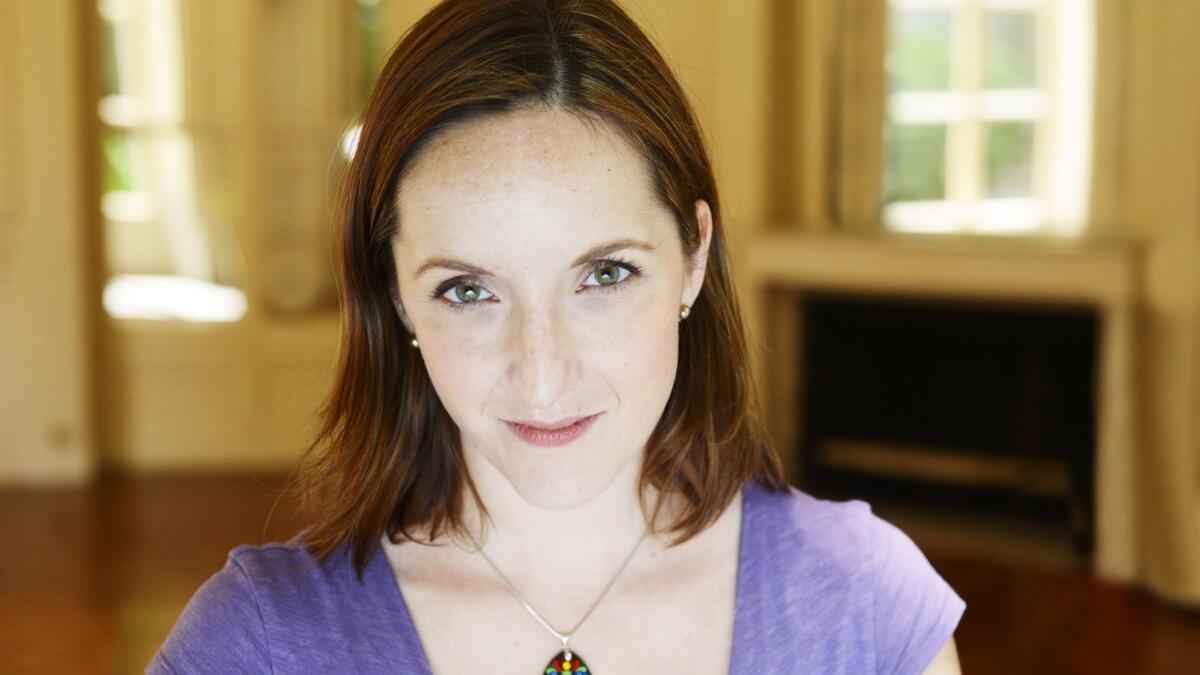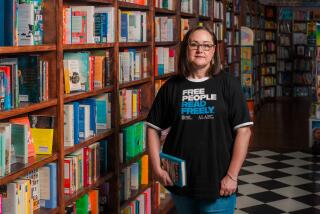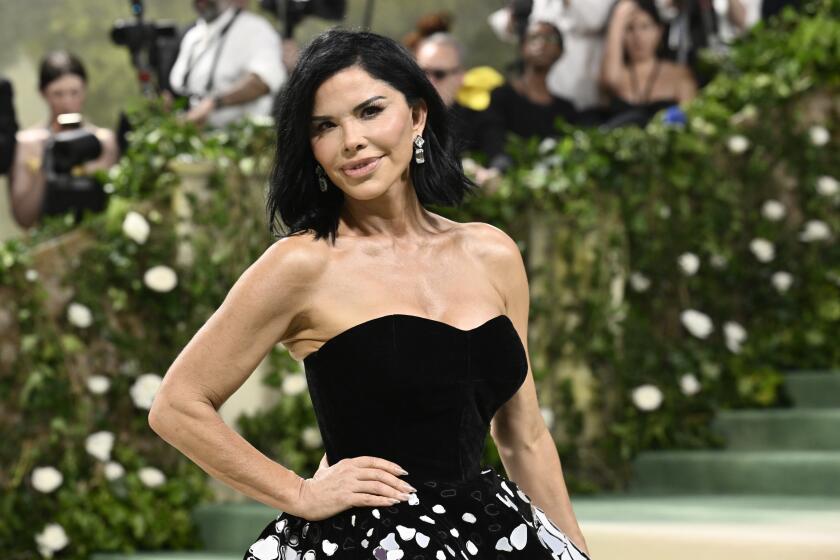Rebecca Makkai on her story of the AIDS era, ‘The Great Believers’

“No one wants to die before the end of the story,” says a character in Rebecca Makkai’s new novel, “The Great Believers.” Unfortunately, many of the people in Makkai’s book aren’t able to outrun death; they’re struck down too young, victims of a plague that was poorly understood at the time.
“The Great Believers” is a story of the AIDS epidemic in the 1980s. The novel follows Yale Tishman, a museum development director who’s trying to acquire an art collection from an elderly woman named Nora who worked as an artist’s model in 1920s Paris. Yale, who is gay, is also dealing with the loss of several of his friends to AIDS, the disease that is ravaging the gay community in Chicago. His story is intercut with chapters featuring his best friend, Fiona, who 30 years later, is still scarred by the loss of her friends, and is trying to locate her long-estranged daughter in Paris.
Makkai comes to Los Angeles to discuss “The Great Believers” at Vroman’s Bookstore in Pasadena with author J. Ryan Stradal on June 21 at 7 p.m. She talked to The Times about her novel via phone, and our conversation was edited.
How did the idea for a book about the AIDS crisis in the 1980s come to you?
I never actually had the idea to write a book about the AIDS crisis; I started off writing a completely different book. There’s a subplot [in “The Great Believers”] with all this stuff about the Paris art world of the 1920s, and that was originally the book. I was originally going to write a story about a woman who had been an artist’s model in 1920s Paris, about the end of her life, which I figured couldn’t be much past the 1980s. I wanted it to be about the ongoing conversations between her and this art collector or historian, who she was trying to convince that in this one painting, it was her in the picture. And my husband very sweetly and helpfully pointed out that that was kind of the plot of the movie “Titanic.” That kind of threw me off a little bit, but in a helpful way.
Meanwhile, I started to get really interested in this art guy, and I started thinking that maybe the AIDS epidemic was a part of this book. The first thing that I actually sat down and wrote was a letter — it’s not in the novel but a letter from the woman who became Nora to the guy who became Yale, talking about the devastation of Paris after World War I, where everyone she knew and loved had been together in this chosen family, this artistic mecca, and coming back there and everyone was gone or damaged or missing or dead. Eventually, the way it shifted for me, it really became about the AIDS epidemic. Partly my research took me there, partly I was just following the story where it wanted to go.
Have you always had an interest in the art world, or specifically that Lost Generation group of artists?
Yeah. It’s not like I’ve done years of research on it or anything, but it’s always been fascinating to me. We talk so much about the Lost Generation, which is the artists, particularly the American artists and writers, who went over after World War I. But there was this whole generation of visual artists who had gotten there before the war, the École de Paris, people like [Chaim] Soutine and [Amedeo] Modigliani and [Tsuguharu] Foujita, who were coming there from all over the world. And then World War I breaks out, and also there’s the influenza [pandemic of 1918], and then they, to some extent, come back, right as the Americans are getting there after the war. That was kind of new to me. I knew a lot about the Lost Generation but I didn’t know as much about what was happening before and during World War I. But I love that stuff. I wasn’t an art major in college or anything, I just love art history, I love those stories of these wild artists living bohemian lives. It’s a little bit of wishful thinking, because I’m an artist, but I’ve got to be a responsible adult. The 21st century is a little different. I’ve got kids.
A lot of novels that have to do with the AIDS crisis seem to take place in New York and San Francisco. How did you decide to set your book in Chicago?
I’ve lived here basically my whole life except for college and a couple of years after. I love writing about Chicago. I resisted it very early in my career, when I was writing short stories in my early twenties. I felt that to be taken seriously, I needed to write about New York, which I had been to, like, twice. And then I started slowly to embrace writing about Chicago in my short stories.
What was really interesting for me is that as I set out to do my research, there was shockingly little about how AIDS affected Chicago, which was and is the third-biggest city in the U.S. It hit quite hard here and in a very concentrated area, because that’s the way Boystown is set up. But if you look, for instance, in the indices of some of the big compendious books about the AIDS epidemic, and you look for Chicago, there’s nothing or next to nothing. Once in a while, they’ll talk about this 1990 ACT UP demonstration that I wrote about in the book. In all the fiction, nonfiction, documentaries, film, the theater, not only is it not about cities like Chicago, it’s neglecting cities like Milwaukee and Baltimore, places that had their own completely idiosyncratic stories and reactions. It’s very much focused on where the epicenters were. But Chicago, for the Midwest, was the epicenter. It was alarming to me that there isn’t more. I was thinking there would be at least one big nonfiction book about AIDS in Chicago, a doctoral dissertation turned into a book or something. And if there is, I have not found it and I’ve been searching for five years, and asking people who would know.
I have not written that book, and someone needs to, someone with better nonfiction chops than me. But in some ways for me, it was a blessing in disguise, because it forced me out from behind my desk and it made me do a lot of legwork for my research. I did a ton of primary source research, looking back at gay weeklies like the Windy City Times, and also in-person interviews with everyone I could find, from doctors and nurses to survivors and activists, lawyers and journalists and basically anyone who would talk to me. And I think it was ultimately much better for my book.
Are there archives of the gay weeklies in Chicago in the ’80s that you were able to find?
Yes. The Harold Washington Library downtown has the Windy City Times from 1985 on, when it started, and completely by coincidence, it’s when my novel starts too. There’s also a library here called the Gerber/Hart Library that is specifically an LGBTQ library, and they have all kinds of great archives, resources, photos and an incredible book section where I was able to find things like this 1987 guide to living with HIV/AIDS that was put out by Johns Hopkins University. One of the things that was really interesting was that I kept finding it was hard to research what the medical knowledge was at certain points. It was wonderful to get this completely out-of-date book of medical stuff that nobody else wanted, for very good reasons. I got my medical information 30 years out of date, which is how I needed it to be.
Talking to survivors of the epidemic in the ’80s — those must have been incredibly emotional conversations.
It was difficult in several ways. First of all, there was quite a hunt to find certain kinds of people. I have an inordinate number of gay friends, but they tend to be around my age, and I have a few friends who are HIV-positive, but it didn’t necessarily feel like I could approach them right off the bat. Really, the unicorn was the people who had been in Chicago in the early ‘80s, out, and in Boystown, and maybe HIV-positive since that time. It was very hard to find people who have lived that long with HIV, but I did end up finding a couple. A lot of that process was having someone introduce me to someone else, interviewing that person, explaining my project, then me asking them who should I talk to next, and then sending me to their friends, and so on.
I eventually really lucked out in one way: I had a writer friend who introduced me to the two doctors who started the AIDS unit at Illinois Masonic Hospital. They were wonderful, and introduced me to all these other people who’d been affiliated with AIDS care at that time. I was completely honored that people were willing to talk to me about, first of all, incredibly personal stuff, in some cases. People were talking to me about their sex lives, after having known me for five minutes, and inviting me, in many cases, into their homes, because they didn’t want to talk about this stuff in Starbucks. And even more so, I was completely honored when they were talking about people they had lost. I have to say, I heard a lot of the first half of stories, and then people couldn’t continue. Which is fine. I didn’t need to hear the endings of the stories, and I wasn’t out for people’s plots. I had my characters, I had my plots. It was the details, the little things that I couldn’t have gotten from a book; it was the emotional osmosis of putting myself in those people’s shoes, hearing stories, seeing pictures, things that allowed me to write with more conviction and more authenticity, and I felt like I could put myself there emotionally.
I think we might be close to the same age; I would have been about 7 in 1985. Do you remember the first time you heard about the AIDS crisis?
I don’t remember a specific first time. We’re the same age, so I think you’ll understand how completely huge it seemed, and was, although I think not all adults saw it the same way. You’re a kid, and you see this on TV, and you haven’t lived through other crises. And you don’t have, hopefully, and I don’t think I did, the callous prejudice of “That’s happening over there, to those people” that adults do, even if they like those people, but it’s over there. Because you’re a kid, you’re porous.
I remember it being absolutely everywhere. I remember kids joking about it at school in really awful ways, but I also remember it being all over the news. If you stayed home sick from school and you watched “Donahue” or something, it was right there. In my early childhood, it wasn’t particularly personal. My parents lost a colleague, but it wasn’t anyone I knew. I grew up in the suburbs, but by the time I was a teenager, I was hanging out in the city, and would go to Boystown with my friends in the early to mid-’90s, just because that was the cool place to go. And it was around. You’d notice. You’d see people sitting on the street with a cardboard sign that said “I’m dying of AIDS, I need money.” And you’d get to high school in the early ’90s, and all of sex ed is all HIV, all the time. Then it starts to come into the popular culture with movies, famous people start dying, people that were on your radar. I remember Howard Ashman, the Disney lyricist, dying, and being really sad and upset, and the in memoriam montages at the Tonys and the Oscars. So it’s distant, but if you are a kid, your worldview is formed around that crisis.
Your novel really strikes me as an act of remembrance. Do you think young people today might not realize how bad the AIDS crisis was in the ’80s?
I think they don’t at all. I didn’t realize that until I was writing this. It’s not that I’ve seen that first hand, but so many people have told me stories about talking to younger people who have been shocked to learn how many friends someone lost, for instance.
I think the corollary to that, though, is that Americans do not understand that there are still a million people dying of AIDS every year. Because many of the deaths are in Africa, it feels like it’s out of sight, out of mind. That’s horrifying, and it’s horrifying that Trump is pulling out of a lot of the ways we were helping internationally right now. There’s always been ignorance around this disease. There was profound ignorance on so many levels in the ’80s and the early ’90s that we in some ways emerged from, but I think that ignorance has been passed on. I think that definitely infuses our lack of thinking about the global issue of AIDS.
You’re doing this campaign, “The Great Believers Donate,” on social media. Can you explain what you’re doing, and how you’re hoping that you can get people to help, in your words, “give back to the community that inspired” this novel?
One of the things I was really struck by in Chicago were the small grassroots organizations that sprang up with no funding in the ’80s and early ’90s, to help in very meaningful but local ways. One of those is an organization that I mention near the end of the book. Someone is leaving the hospital and talks about how this organization called Open Hand had already been at their apartment stocking the fridge. This is an organization that would do meal delivery and grocery delivery. They’ve changed their name, they’re now Vital Bridges, and they’ve transformed into basically a food pantry and free grocery store; people with HIV or AIDS come in and can fill their shopping cart. The woman who runs has run it from the very beginning, this Chicago activist named Lori Cannon, is just legendary here. She was a wonderful resource for me in writing this book. She brought me into the grocery store on a day when it was closed, and we sat there for hours, and she told me stories.
I wanted to give something back to the AIDS community in Chicago, to a smaller organization where my very limited funds could actually make some kind of difference. And so the deal is if people take a photo of the book, a book that they’ve purchased, because in order for me to afford this, people have to buy the book, and post it to Instagram or Twitter or my Facebook page with the hashtag #TheGreatBelieversDonate, I am able then to donate a dollar each time. Also I have a couple of bookstores doing matching donations if the book was purchased at that store. I’m hoping to get some more organizations doing matching donations in their own cities, maybe with small organizations in cities other than Chicago. I don’t know how far it’s going to go, but I think it’s worth a shot, and I’d really love to go broke doing it, so I hope people will participate.
Schaub is a writer in Texas.
More to Read
Sign up for our Book Club newsletter
Get the latest news, events and more from the Los Angeles Times Book Club, and help us get L.A. reading and talking.
You may occasionally receive promotional content from the Los Angeles Times.









